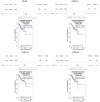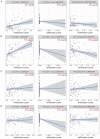Investigating novel biomarkers in uterine corpus endometrial carcinoma: in silico analysis and clinical specimens validation via RT-qPCR and immunohistochemistry
- PMID: 37818076
- PMCID: PMC10560950
Investigating novel biomarkers in uterine corpus endometrial carcinoma: in silico analysis and clinical specimens validation via RT-qPCR and immunohistochemistry
Abstract
The rising incidence and mortality rate of Uterine Corpus Endometrial Carcinoma (UCEC) pose significant health concerns. CC and CXC chemokines have been linked to tumorigenesis and cancer progression. Recognizing the growing significance of CC and CXC chemokines' diagnostic and prognostic significance in diverse cancer types, our objective was to comprehensively analyze the diagnostic and prognostic values of hub genes from the CC and CXC chemokines in UCEC, utilizing both in silico and clinical samples and cell lines-based approaches. In silico analyses include STRING, Cytoscape, Cytohubba, The Cancer Genome Atlas (TCGA) datasets analysis via the UALCAN, GEPIA, OncoDB, and MuTarget, SurvivalGenie, MEXPRESS, cBioPoratal, TIMER, ENCORI, and DrugBank. Meanwhile, clinical samples and cell lines based analyses include Reverse transcription-quantitative polymerase chain reaction (RT-qPCR), targeted bisulfite sequencing (bisulfite-seq) analysis, and immunohistochemistry (IHC). Through present study, we identified CCL25 (CC motif chemokine ligand 25), CXCL10 (C-X-C motif chemokine ligand 10), CXCL12 (C-X-C motif chemokine ligand 12), and CXCL16 (C-X-C motif chemokine ligand 16) as crucial hub genes among the CC and CXC chemokines. Analyzing the expression data from TCGA, we observed a significant up-regulation of CCL25, CXCL10, and CXCL16 in UCEC samples compared to controls. In contrast, we noted a significant down-regulation of CXCL12 expression in UCEC samples. On clinical UCEC samples and cell lines analysis, the significant higher expression of CCL25, CXCL10, and CXCL16 and significant lower expression of CXCL12 were also denoted in UCEC samples than the controls via RT-qPCR and IHC analyses. Moreover, in silico analysis also confirmed the abnormal promoter methylation levels of the hub genes in TCGA UCEC samples, which was later validated by the clinical samples using targeted based bisulfite-seq analysis. In addition, various additional aspects of the CCL25, CXCL10, CXCL12, and CXCL16 have also been uncovered in UCEC during the present study. Our findings offer novel insights that contribute to the clinical utility of CCL25, CXCL10, CXCL12, and CXCL16 chemokines as potential diagnostic and prognostic biomarkers in UCEC.
Keywords: CC and CXC chemokines; UCEC; biomarkers.
AJCR Copyright © 2023.
Conflict of interest statement
None.
Figures











Similar articles
-
Integrated multiplex network based approach reveled CC and CXC chemokines associated key biomarkers in colon adenocarcinoma patients.Am J Cancer Res. 2023 Nov 15;13(11):5531-5548. eCollection 2023. Am J Cancer Res. 2023. PMID: 38058831 Free PMC article.
-
Key wound healing genes as diagnostic biomarkers and therapeutic targets in uterine corpus endometrial carcinoma: an integrated in silico and in vitro study.Hereditas. 2025 Jan 21;162(1):5. doi: 10.1186/s41065-025-00369-9. Hereditas. 2025. PMID: 39833941 Free PMC article.
-
Identifying and validating MMP family members (MMP2, MMP9, MMP12, and MMP16) as therapeutic targets and biomarkers in kidney renal clear cell carcinoma (KIRC).Oncol Res. 2024 Mar 20;32(4):737-752. doi: 10.32604/or.2023.042925. eCollection 2024. Oncol Res. 2024. PMID: 38560573 Free PMC article.
-
CXC chemokines: Potential biomarker and immunotherapeutic target for uterine corpus endometrial carcinoma.PLoS One. 2024 Jan 17;19(1):e0277872. doi: 10.1371/journal.pone.0277872. eCollection 2024. PLoS One. 2024. PMID: 38232115 Free PMC article.
-
LINC01589 serves as a potential tumor-suppressor and immune-related biomarker in endometrial cancer: A review.Medicine (Baltimore). 2023 Apr 14;102(15):e33536. doi: 10.1097/MD.0000000000033536. Medicine (Baltimore). 2023. PMID: 37058060 Free PMC article. Review.
Cited by
-
Present progress in biomarker discovery of endometrial cancer by multi-omics approaches.Clin Proteomics. 2025 Apr 26;22(1):15. doi: 10.1186/s12014-025-09528-6. Clin Proteomics. 2025. PMID: 40281423 Free PMC article. Review.
References
-
- Wang Y, Xu M, Yang Q. A six-microRNA signature predicts survival of patients with uterine corpus endometrial carcinoma. Curr Probl Cancer. 2019;43:167–176. - PubMed
-
- Usman M, Hameed Y, Ahmad M, Iqbal MJ, Maryam A, Mazhar A, Naz S, Tanveer R, Saeed H, Bint-E-Fatima, Ashraf A, Hadi A, Hameed Z, Tariq E, Aslam AS. SHMT2 is associated with tumor purity, CD8+ T immune cells infiltration, and a novel therapeutic target in four different human cancers. Curr Mol Med. 2023;23:161–176. - PubMed
-
- Wheelock CE, Goss VM, Balgoma D, Nicholas B, Brandsma J, Skipp PJ, Snowden S, Burg D, D’Amico A, Horvath I, Chaiboonchoe A, Ahmed H, Ballereau S, Rossios C, Chung KF, Montuschi P, Fowler SJ, Adcock IM, Postle AD, Dahlén SE, Rowe A, Sterk PJ, Auffray C, Djukanovic R U-BIOPRED Study Group. Application of omics technologies to biomarker discovery in inflammatory lung diseases. Eur Respir J. 2013;42:802–825. - PubMed
LinkOut - more resources
Full Text Sources
